[Python] Python 学习 - 可视化数据操作(一)
Python 学习 - 可视化数据操作(一)
GitHub:https://github.com/liqingwen2015/my_data_view
目录
- 折线图
- 散点图
- 随机漫步
- 骰子点数概率
- 文件目录
折线图
cube_squares.py
import matplotlib.pyplot as plt x_values=list(range(1, 5000))
y_values=[pow(x, 3) for x in x_values] plt.scatter(x_values, y_values, c=y_values, cmap=plt.cm.Blues, edgecolor='none', s=40) # 设置标题和样式
plt.title("Square Numbers", fontsize=24)
plt.xlabel("Value", fontsize=14)
plt.ylabel("Square of Value", fontsize=14) # 设置刻度标记的大小
plt.tick_params(axis='both', which='major', labelsize=14) plt.show()

mpl_squares.py
# 简单的折线图
import matplotlib.pyplot as plt input_values=[1, 2, 3, 4, 5 ]
squares = [1, 4, 9, 16, 25] # 绘制线条的粗细
plt.plot(input_values, squares, linewidth=5) # 设置图表标题,并给坐标轴加上标签
plt.title("Square Numbers", fontsize=24)
plt.xlabel("Value", fontsize=14)
plt.ylabel("Square of Value", fontsize=14) # 设置刻度标记的大小,axis='both' 表示指定的实参影响 x 轴和 y 轴上的刻度
plt.tick_params(axis='both', labelsize=14) plt.show()

散点图
scatter_squares.py
# 散点图 import matplotlib.pyplot as plt x_values = list(range(1, 1001))
y_values = [x**2 for x in x_values] # c:颜色
#plt.scatter(x_values, y_values, c='red', edgecolor='none', s=40)
#plt.scatter(x_values, y_values, c=(0, 0, 8), edgecolor='none', s=40)
plt.scatter(x_values, y_values, c=y_values, cmap=plt.cm.Blues, edgecolor='none', s=40) # 设置标题和样式
plt.title("Square Numbers", fontsize=24)
plt.xlabel("Value", fontsize=14)
plt.ylabel("Square of Value", fontsize=14) # 设置刻度标记的大小
plt.tick_params(axis='both', which='major', labelsize=14) plt.show() # 保存图表
#plt.savefig('squared_plot.png', bbox_inches='tight')
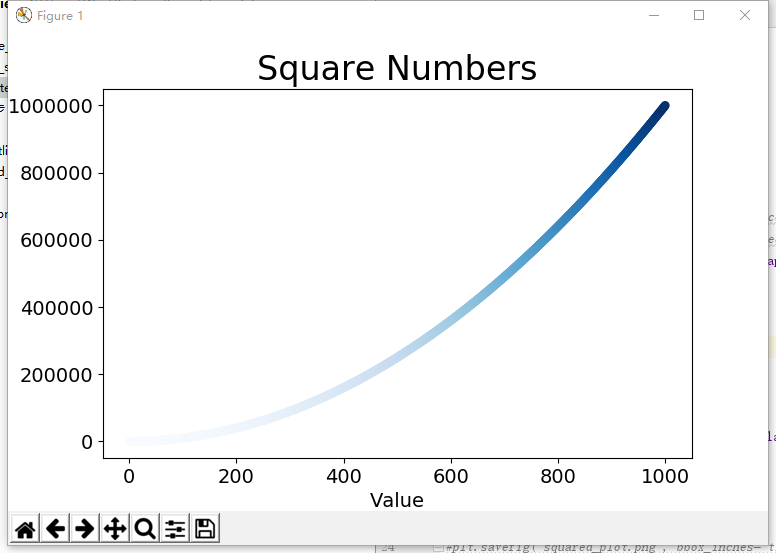
随机漫步
random_walk.py
from random import choice
class RandomWalk():
def __init__(self, num_points=5000):
# 初始化随机漫步的属性
self.num_points = num_points
# 所有随机漫步都始于(0, 0)
self.x_values = [0]
self.y_values = [0]
def fill_walk(self):
# 不断漫步,直到列表达到指定的长度
while len(self.x_values) < self.num_points:
x_step = self.get_step();
y_step = self.get_step();
# 拒绝原地踏步
if x_step == 0 and y_step == 0:
continue
# 计算下一个点的 x 和 y 值
next_x = self.x_values[-1] + x_step
next_y = self.y_values[-1] + y_step
self.x_values.append(next_x)
self.y_values.append(next_y)
def get_step(self):
# 决定前进方向以及沿这个方向前进的距离
direction = choice([1, -1]) # 随机选 1 或 -1
distance = choice([0, 1, 2, 3, 4]) # 随机选 0, 1, 2, 3, 4
return direction * distance # 正数:右移,负数:左移
rw_visual.py
import matplotlib.pyplot as plt from 随机漫步.random_walk import RandomWalk while True:
# 创建一个 RandomWalk 实例,并将其包含的点都绘制出来
rw = RandomWalk(5000)
rw.fill_walk() point_numbers = list(range(rw.num_points))
plt.scatter(rw.x_values, rw.y_values, c=point_numbers, cmap=plt.cm.Blues, edgecolors='none', s=1) # 设置绘图窗口的尺寸
#plt.figure(dpi=128, figsize=(10, 6)) # 突出起点和终点
plt.scatter(0, 0, c='green', edgecolors='none', s=100)
plt.scatter(rw.x_values[-1], rw.y_values[-1], c='red', edgecolors='none', s=100) #plt.plot(rw.x_values, rw.y_values, linewidth=10) # 隐藏坐标轴
plt.axes().get_xaxis().set_visible(False)
plt.axes().get_yaxis().set_visible(False) plt.show() keep_running = input("继续?(y/n):")
if keep_running == 'n':
break
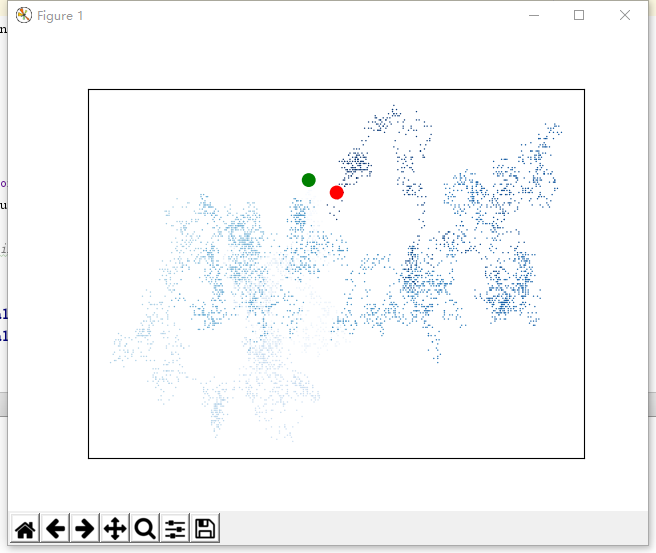
骰子点数概率
die.py
from random import randint class Die():
# 表示一个骰子类 def __init__(self, num_sides=6):
# 6 面
self.num_sides = num_sides def roll(self):
# 返回 1~6
return randint(1, self.num_sides)
die_visual.py
import pygal from 骰子.die import Die # 创建一个 D6
die = Die() results = []
for roll_num in range(1000):
result = die.roll()
results.append(result) frequencies = []
for value in range(1, die.num_sides+1):
# 计算某个值出现同样的次数
frequency = results.count(value)
frequencies.append(frequency) # 对结果进行可视化
hist = pygal.Bar() hist.title = "D6 1000次:"
hist.x_labels = [str(num) for num in range(1, 7)] #['1', '2', '3', '4', '5', '6']
hist.x_title = "结果"
hist.y_title = "概率" hist.add('D6', frequencies)
hist.render_to_file('images/die_visual.svg')
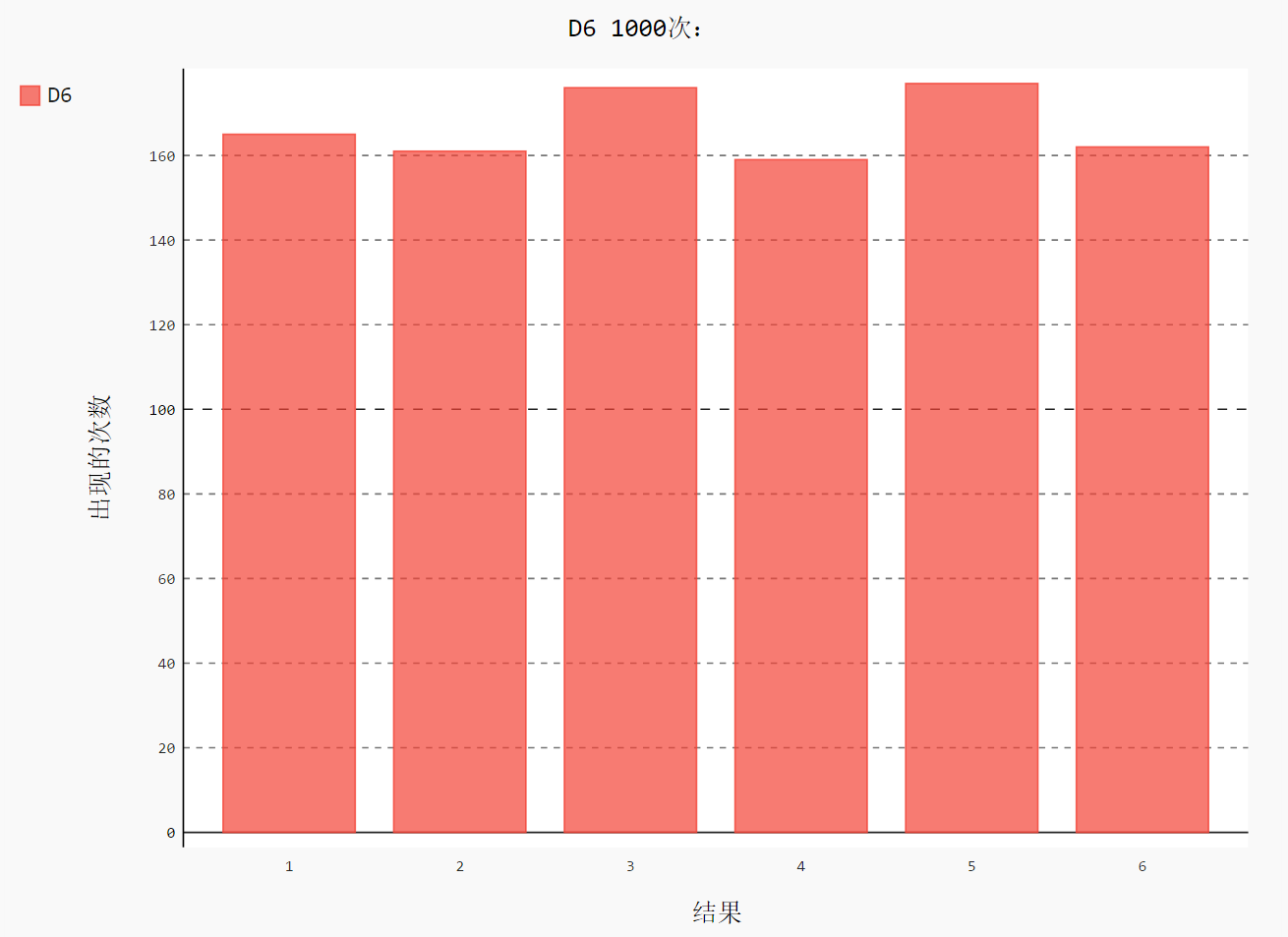
dice_visual.py
import pygal from 骰子.die import Die # 创建 2 个 D6
die_1 = Die()
die_2 = Die() results = []
for roll_num in range(1000):
result = die_1.roll() + die_2.roll()
results.append(result) frequencies = []
max_results = die_1.num_sides + die_2.num_sides
for value in range(2, max_results+1):
# 计算某个值出现同样的次数
frequency = results.count(value)
frequencies.append(frequency) # 对结果进行可视化
hist = pygal.Bar() hist.title = "D6 100次:"
hist.x_labels = [str(num) for num in range(1, 13)] #['1', '2', '3', '4', '5', '6', '7', '8', '9', '10', '11', '12']
hist.x_title = "结果"
hist.y_title = "出现的次数" hist.add('D6 + D6', frequencies)
hist.render_to_file('images/dice_visual.svg')

different_dice.py
import pygal from 骰子.die import Die # 创建一个 D6 和 D10
die_1 = Die()
die_2 = Die(10) results = []
for roll_num in range(5000):
result = die_1.roll() + die_2.roll()
results.append(result) frequencies = []
max_results = die_1.num_sides + die_2.num_sides
for value in range(2, max_results+1):
# 计算某个值出现同样的次数
frequency = results.count(value)
frequencies.append(frequency) # 对结果进行可视化
hist = pygal.Bar() hist.title = "5000 次:D6 + D10 的结果。"
hist.x_labels = [str(num) for num in range(2, 17)]
hist.x_title = "结果"
hist.y_title = "重复出现的次数" hist.add('D6 + D10', frequencies)
hist.render_to_file('images/different_visual.svg')
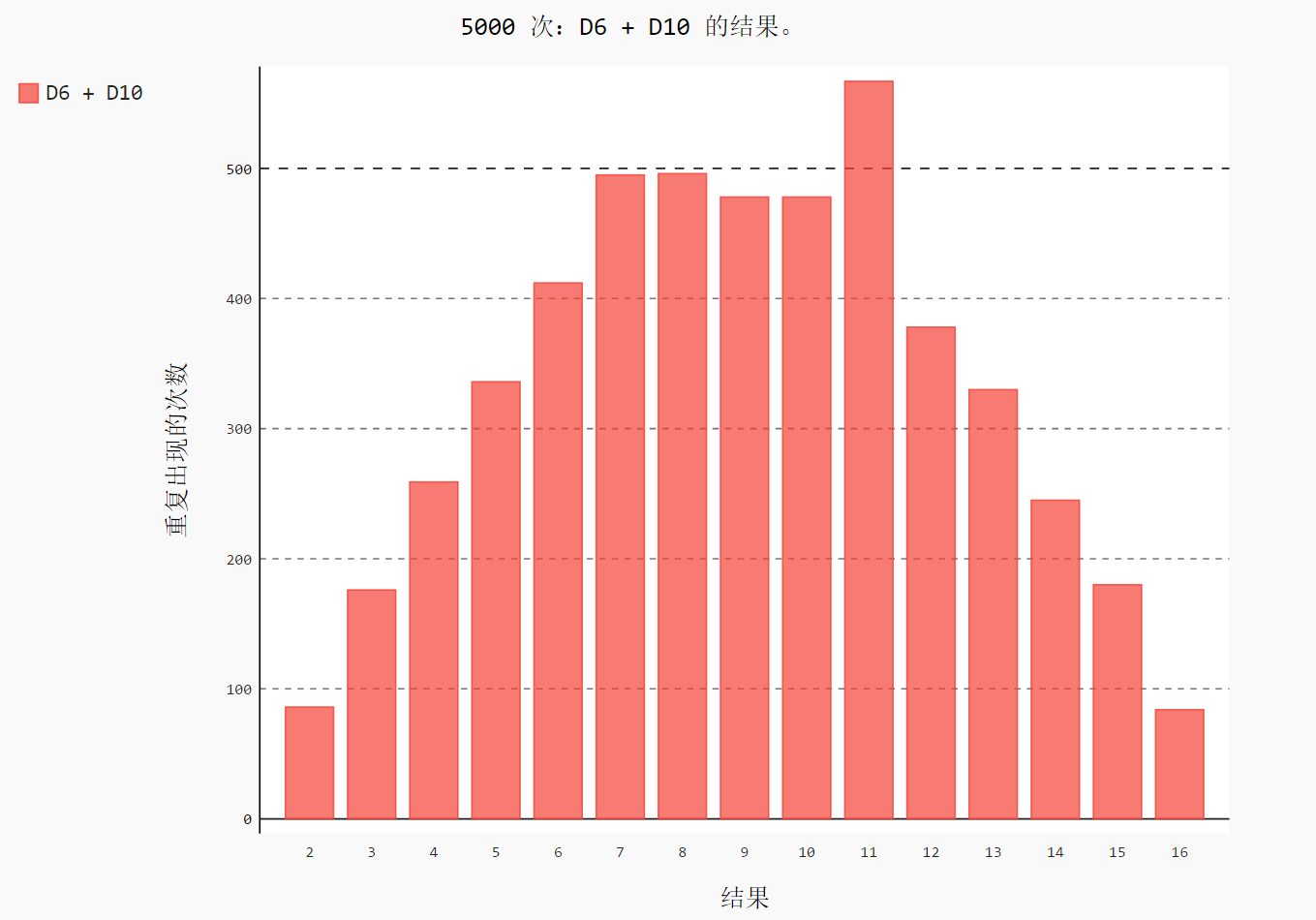
文件目录
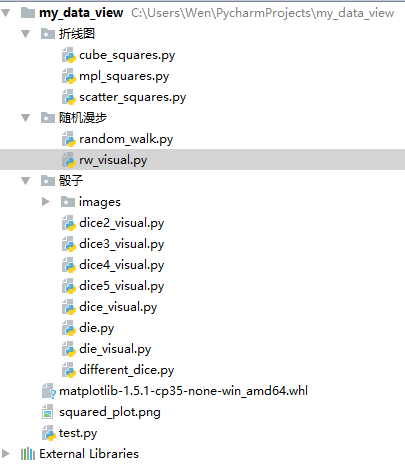
GitHub:https://github.com/liqingwen2015/my_data_view
[Python] Python 学习 - 可视化数据操作(一)的更多相关文章
- python入门学习:3.操作列表
python入门学习:3.操作列表 关键点:列表 3.1 遍历整个列表3.2 创建数值列表3.3 使用列表3.4 元组 3.1 遍历整个列表 循环这种概念很重要,因为它是计算机自动完成重复工作的常 ...
- Python进阶学习_连接操作Redis数据库
安装导入第三方模块Redis pip3 install redis import redis 操作String类型 """ redis 基本命令 String set(n ...
- linux学习之——数据操作:添加与查询
说明: 在linux系统中,利用搭建的服务器,编写两个页面,一个添加信息,一个展现信息: 主要涉及到:php+mysql的操作: 数据添加页面: <html> <head> & ...
- python基础学习之文件操作&函数
1.文件处理相关 1.编码问题 ①python2与python3中的默认编码: py2默认使用ASCII码,py3默认使用utf-8 ②为什么会出现中文乱码,中文乱码的情况有哪些? #sys.stdo ...
- Python基础学习七 Excel操作
python操作excel,python操作excel使用xlrd.xlwt和xlutils模块, xlrd模块是读取excel的,xlwt模块是写excel的,xlutils是用来修改excel的. ...
- python基础学习笔记——文件操作
文件操作 初始文件操作 使用Python来读写文件是非常简单的操作,我们使用open()函数来打开一个文件,获取到文件句柄,然后通过文件句柄就可以进行各种各样的操作了 根据打开方式的不同能够执行的操作 ...
- python自动化测试学习笔记-6excel操作xlwt、xlrd、xlutils模块
python中通过xlwt.xlrd和xlutils操作xls xlwt模块用于在内存中生成一个xls/xlsx对象,增加表格数据,并把内存中的xls对象保存为本地磁盘xls文件; xlrd模块用于把 ...
- [python][django学习篇][6]操作数据库
查询(取)数据 >>> Category.objects.all() <QuerySet [<Category: Category object>]> > ...
- 莫烦python教程学习笔记——数据预处理之normalization
# View more python learning tutorial on my Youtube and Youku channel!!! # Youtube video tutorial: ht ...
随机推荐
- vue相关文件说明(基于vue2.0)
1.config:生产,开发环境配置参数 2.static:第三方资源,这里面的文件直接写路径,不能用'import'导入 3.node_modules:引入一些依赖包 4..babelrc:定义了E ...
- libevent入门介绍
libevent是之前看到的一个别人推荐的清凉级网络库,我就想了解一下它.今天下载到了一个人写的剖析系列,从结构和源码方面进行了简要分析.只是这个分析文章是2010年的,有点过时了(跟现在的libev ...
- 4.23 Linux(3)
2019-4-23 19:03:53 买的服务器第三天感觉超爽!! 发现学习Linux超爽,有种操作的快感!!!!!是Windows比不了的!! 阿里巴巴镜像源 : https://opsx.alib ...
- Bootstrap 常用属性
一,关于按钮 btn系列 二.关于div 移动位置 col 系列 col-md 系列 col-lg系列 这些都是让多个div在当前页面等大小 三.居中系列 1.文本居中 text-center 2.图 ...
- js jq 字符串数组对象
数组是有序的,对象是无序,数组是特殊的对象 数组 声明数组 var arr=new Array('red','blue','yellow'); //["red", "bl ...
- jsplumb 中文教程
https://wdd.js.org/jsplumb-chinese-tutorial/#/ 1. jsplumb 中文基础教程 后续更新会在仓库:https://github.com/wangdua ...
- mysql 主主+ Keepalived 高可用
这是在mysql互为主从的基础上做的 yum -y install keepalived #两台机器上都装 配置Keepalived主从, vrrp_instance VI_1 { state ...
- python之Django学习笔记(二)---Django从工程创建、app创建到表建模在页面的显示
创建工程: 在命令行中切换目录至需要创建工程的目录,然后在命令行中输入如下命令创建djangoTestPro工程 D:\PycharmProjects\untitled\MyTestProject&g ...
- Python 使用图灵机器人实现微信聊天功能
首先需要去图灵官网创建一个属于自己的机器人然后得到apikey. 一.自动与指定好友聊天 # -*- coding: utf-8 -*- """ Created at 2 ...
- LinkedHashMap 底层分析
众所周知 HashMap 是一个无序的 Map,因为每次根据 key 的 hashcode 映射到 Entry 数组上,所以遍历出来的顺序并不是写入的顺序. 因此 JDK 推出一个基于 HashMap ...
